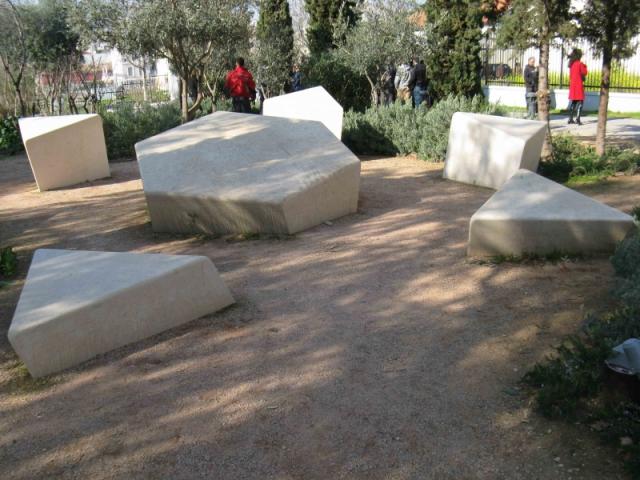- It is about the greatest mass murder of Thessaloniki citizens that has ever happened (1943–1944), elsewhere (in Auschwitz), with some victims who were ‘the other’ (Jews were different for the Orthodox, Greek-speaking national element), its perpetrators being some foreigners (the German invaders). Do the mentioned parameters justify the exclusion of that crime from the history of the city? This was the position of the city council in the summer of 2008 when it refused to include Thessaloniki in the Network of Martyr Cities and Villages of Greece. One argument was that the extermination of 96% of Jews from Thessaloniki (the actual percentage is 96%) would not turn the city of Thessaloniki into a martyr, as the offence "was committed outside Thessaloniki!" Approximately 50,000 Thessaloniki Jews perished, they were killed "elsewhere", which is why this event is not part of the city's history. The second argument was that Jews had inhabited the city "just" for five hundred years! In addition to the historical mistake, because these five-hundred years of existence refer to the Sephardic community, i.e. Hispanic Jews, whereas Jews had lived in the city since the first century AD, this argument is absolutely untenable since it is clear that less than five hundred years are more than enough for a proactive community (and the largest one in the city for many centuries) to leave its mark on the history of the city. Therefore, Thessaloniki missed not only the chance of joining the Network of Martyr Cities and Villages of Greece but mainly the opportunity of self-awareness, thus perpetuating a systematic oblivion. Ghosts unfortunately remained ghosts instead of actually becoming the past and a past trauma.
- You examine in detail the issue of the identity of the Sephardic Jews of Thessaloniki and of identities in general in the text "A journey dedicated to Sephardic Jews of Thessaloniki", which is about the book "Memories of a Life and a World" by long-time president of the Israelite community in the city Andreas Shephiha, edited by experienced journalist Sofia Pakalidou. How are policies changing to highlight the multicultural aspect of this city?
- The Jew was par excellence "the other, the different one" and the Greek national narrative did not include Jews up to the 1980s. These publications and discussions have become more frequent since the 1990s. The Resistance, the Civil War, the main historical trauma of Greek society were also taboo topics. I explore these issues elsewhere in my book "Youth in the Maelstrom of Occupied Greece" (published by Estia, 2008). I wonder how much more could the extermination of a national element (a bearer of an absolutely particular culture, namely the Sephardic one) that had inhabited a city and comprised the most populous and vibrant part of its population for 450 years (from 1492, the year of its expulsion from Spain to 1943 when it was deported by the Nazis) mark the history of this city? The part that had reinvigorated the Ottoman city deserted in the early sixteenth century to turn it into "Madre de Israel", "Jerusalem of the Balkans" and make the Sephardic culture shine not only in the western but also in the eastern end of the Mediterranean, and of course, deep down in the Balkan hinterland. So the 16th-17th centuries became the golden age of Thessaloniki Jewry, but of the city too, as it was its strongest ethnic element. The crime had left multiple traces on the body of the city itself.
Things are changing, however. The events that took place last March in Thessaloniki, under the auspices of the Municipality and upon the initiative of Mayor Yiannis Boutaris, on the occasion of the seventieth anniversary of the sending of the first group of 2000 Greek Jews to Auschwitz show that different wind is blowing. This will further open our collective memory and our society will gain self-awareness as well as new acute sensitiveness against all forms of racism. It is because the memory of the genocide of Jews in Europe is still, and must remain, emblematic of all victims of racism.

- What is the broader thematic range of the book?
- The memory-oblivion connection as well as that between silence and writing are explored both in the word of witnesses and in the texts of camp literature, e.g. primarily the works by Primo Levi and Jorge Semprun. Other texts treat issues such as the reconstruction of the events based on testimonies and camp literature, the denial of the Holocaust, the historiography of the genocide. The issue of revisionism that denies it refer to the approach of Pierre Vidal-Naquet and other researchers, and in relation to the issue of memory the views of Tzvetan Todorov are cited. The most recent texts refer to the institutionalization of memory through places of memory, museums (in a separate text about the issues of the Holocaust museums), monuments and anniversaries (27 January, the International Holocaust Remembrance Day). Therefore, the approach to the event is multi-dimensional and is directed towards its historicizing.